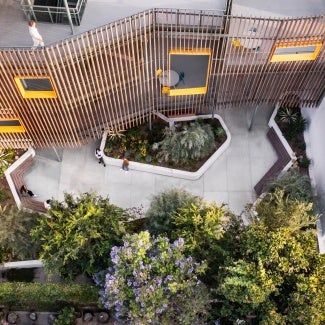Cooperwood Senior Living
The award-winning design for aging of Cooperwood Senior Living in Flowood, Mississippi creates a vibrant living space with nature views from each room while remaining financially feasible for the community.

Project highlights: Cooperwood Senior Living
- Architect: Duvall Decker
- Location: Flowood, Mississippi
- Category: Merit
This affordable 80-unit assisted living and memory care community in central Mississippi reimagines a growing housing typology. Neither an institution nor a big “house” filled with minimal units, the project is architecture for people whose lives are fully integrated into the environment and community. It offers its residents a sense of belonging, bolstered by the developer’s desire to serve a growing senior community.
The site was originally purchased at auction by a father and son developer team in the mid-1990s, and, over more than two decades, the community surrounding the site thrived. As the population aged, the developers reflected on their personal experiences caring for elderly family members and their dismay with institutional facilities or extremely expensive senior centers. With those experiences in mind, Cooperwood Senior Living embraces and condenses two scales of home and community into a vibrant living environment that is both familiar and surprising.
The project’s siting embraces and improves a preexisting drainage ditch that flows through the site. What originally presented as a challenging condition has been transformed into a landscaped pond and natural habitat, which is surrounded by a unique senior development comprising residential wings on the east and west that are linked by a central community building.
Cooperwood Senior Living was conceived as a full living environment that includes private units and numerous delightful public spaces—outdoor patio space, a cafe, a theater, and a salon —that overlook the water. All of the project’s residential units face east or west, and each includes multiple large windows that offer views of the sunrise or sunset. They’re protected from the South’s hot sun by shades that shelter the interior from heat and glare and simultaneously reflect light back onto the project’s faceted facade. By opening the interior to views of the water, ducks, songbirds, and other seasonal fauna, Cooperwood’s residents are presented with a sense of discovery.
The developer wanted the facility to remain financially feasible for middle- and lower-income families, which shaped a limited construction budget. The team’s economical choices for every design and construction decision allowed the project to be realized for less than $237 per square foot.
Framework for Design Excellence Measures
Was there a design charrette? Yes
Site area that supported vegetation (landscape or green roof) pre-development: 100%
Site area that supports vegetation post-development: 84%
Site area covered by native plants supporting native or migratory species and pollinators: 20%
Strategies used to promote Design for Ecosystems: Biodiversity, Bird
safety, Soil conservation, Habitat conservation, flora/fauna
Is potable water used for irrigation? Yes
Is potable water used for cooling? Yes
Is grey/blackwater reused on-site? No
Is rainwater collected on-site? No
Stormwater managed on-site: 100%
2030 Commitment baseline EUI: 40 kBtu/sf/yr
Predicted net EUI including on-site renewables: 32 kBtu/sf/yr
Reduction from the benchmark: 20%
Is the project all-electric? Yes
Level of air filters installed: MERV 12-14
Was a “chemicals of concern” list used to inform material selection? Yes
Do greater than 90% of occupied spaces have a direct view to the outdoors? Yes
Were embodied carbon emissions estimated for this project? Yes
Estimated service life: 75 years
Ability to survive without utility power: Partial back-up power
Has a post-occupancy evaluation been conducted? Yes
Building performance transparency steps taken:
* Present the design, outcomes, and/or lessons learned to the office,
* Present the design, outcomes, and/or lessons learned to the profession,
* Present the design, outcomes, and/or lessons learned to the public,
* Publish lessons learned from design, construction, and/or occupancy.
Project team & Jury
Gross conditioned floor area: 76,000 sq. ft.
Associate Architect: Duvall Decker
Engineer - Civil: Waggoner Engineering
Engineer - MEP: Engineering Resource Group
Engineer - Structural: Spencer-Engineers, Inc.
General Contractor: Fountain Construction Co Inc.
Landscape Architect: WAS Design
Jennifer Sodo, AIA, Chair, EUA, Milwaukee
Winifred Elysse Newman, Assoc. AIA, Clemson University, Clemson, S.C.
Philippe Saad, AIA, DiMella Shaffer, Boston
Margaret Suit, Erickson Senior Living, Catonsville, Md.
Lisa Warnock, Glow Interior Designs, Portland, Ore.
The Design for Aging Review showcases facilities that represent conscientious surroundings and advance environments for senior living.
Five projects showcase the best in senior living communities.













